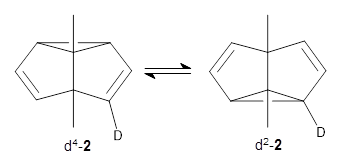Over the past nine years the Schreiner group, often in collaboration with the Allen group, have produced some remarkable studies demonstrating the role of tunneling control. (I have made quite a number of posts on this topics.) Tunneling control is a third mechanism for dictating product formation, in tandem with kinetic control (the favored product is the one that results from the lowest barrier) and thermodynamic control (the favored product is the one that has the lowest energy). Tunneling control has the favored product resulting from the narrowest mass-considered barrier.
Schreiner has written a very clear perspective on tunneling control. It is framed quite interestingly by some fascinating quotes:
It is probably fair to say that many organic chemists view the concept of tunneling, even of hydrogen atoms, with some skepticism. – Carpenter 19832
Reaction processes have been considered as taking place according to the laws of classical mechanics, quantum mechanical theory being only employed in calculating interatomic forces. – Bell 19333
Schreiner’s article makes it very clear how critical it is to really think about reactions from a truly quantum mechanical perspective. He notes the predominance of potential energy diagrams that focus exclusively on the relative energies and omits any serious consideration of the reaction coordinate metrics, like barrier width. When one also considers the rise in our understanding of the role of reaction dynamics in organic chemistry (see, for example, these many posts), just how long will it take for these critical notions to penetrate into standard organic chemical thinking? As Schreiner puts it:
It should begin by including quantum phenomena in introductory textbooks, where they are, at least in organic chemistry, blatantly absent. To put this oversight in words similar to those used much earlier by Frank Weinhold in a different context: “When will chemistry textbooks begin to serve as aids, rather than barriers, to this enriched quantum-mechanical perspective?”4
References
1) Schreiner, P. R., "Tunneling Control of Chemical Reactions: The Third Reactivity Paradigm." J. Am. Chem. Soc. 2017, 139, 15276-15283, DOI: 10.1021/jacs.7b06035.
2) Carpenter, B. K., "Heavy-atom tunneling as the dominant pathway in a solution-phase reaction? Bond shift in antiaromatic annulenes." J. Am. Chem. Soc. 1983, 105, 1700-1701, DOI: 10.1021/ja00344a073.
3) Bell, R. P., "The Application of Quantum Mechanics to Chemical Kinetics." Proc. R. Soc. London, Ser. A 1933, 139 (838), 466-474, DOI: 10.1098/rspa.1933.0031.
4) Weinhold, F., "Chemistry: A new twist on molecular shape." Nature 2001, 411, 539-541, DOI: 10.1038/35079225.


